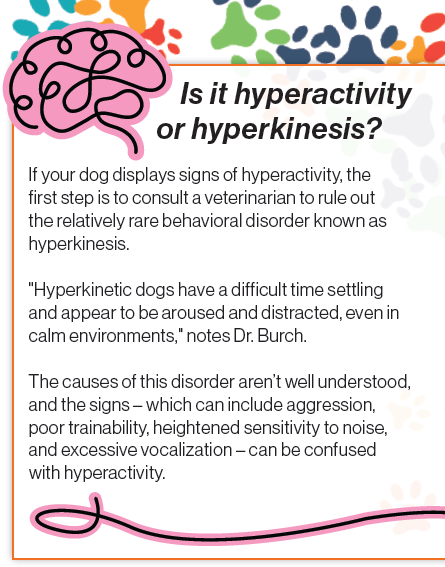Explore hyperactivity in dogs (Canine ADHD): causes, signs, and tips for management with training, exercise, and environmental adjustments.
Dogs can display ADHD-like signs such as hyperactivity, impulsivity and inattention. What causes these behaviors, can we compare them to human ADHD, and how do we manage the disorder?
We’ve come a long way in understanding behaviors related to focus and hyperactivity in humans. Gone are the days when children struggling to sit still and concentrate were unjustly labeled as less intelligent. We now recognize that both hereditary and environmental factors influence attention deficit/hyperactivity disorder (ADHD). It affects approximately 4% of adult North Americans. Interestingly, dogs can also exhibit hyperactivity, along with impulsivity and inattention. How does this disorder compare to ADHD in humans, and how can it be addressed and managed?
Flag it: Research indicates about 12% to 15% of dogs exhibit hyperactivity and impulsivity, while 20% show signs of inattention.
As in humans, hyperactivity in dogs results from a combination of hereditary and environmental influences. Recent studies from the University of Helsinki have identified key environmental factors affecting ADHD-like behaviors in dogs. For example, researchers found that dogs who spend a lot of time alone during the day are more likely to become hyperactive, impulsive, and inattentive.
Exploring ADHD-like behavior in dogs – insights from research
To understand ADHD-like behavior in dogs, it’s essential to recognize the fundamental cognitive differences between humans and canines. “Dogs possess unique cognitive abilities, and their behavior is shaped by a multitude of factors, including genetics, breed predispositions [e.g. working dogs are more prone to hyperactivity], and environmental elements,” says Dr. Sarah Anderson, a veterinarian specializing in animal behavior. “Drawing direct parallels to human conditions requires caution.”
Let’s look at what the research has revealed so far:

- Genetic influences: In 2020, Dr. James Peterson, a geneticist at the Canine Behavior Research Institute, published a groundbreaking study.
Flag it: Dr. Peterson’s research identified a specific gene, Insulin-like Growth Factor 1 (IGF1), linking it to hyperactivity in certain dog breeds.
“Genetics appears to play a substantial role in the development of ADHD-like traits in dogs,” he says. “These genetic insights offer potential avenues for further research and customized interventions.”
- Environmental factors: Maria Rodriguez, an animal behaviorist, delved into the impact of environmental factors on hyperactive dogs. Her 2017 study also looked at the importance of environmental enrichment. “Increased physical and mental stimulation, along with a structured routine, can be instrumental in mitigating hyperactivity and attention issues in dogs,” she notes. “A stimulating environment can profoundly influence canine behavior.”
- Behavioral training: Mark Collins, an expert in canine behavior and training, conducted numerous studies on structured training. His research focused on the efficacy of behavioral interventions for hyperactive dogs. “Training is a powerful tool in addressing canine hyperactivity and can lead to positive behavior outcomes,” he states.
Flag it: Positive reinforcement techniques and consistent routines can significantly improve attention and reduce hyperactivity in dogs, research shows.
Managing Hyperactivity in Dogs – physical and mental stimulation is key
It’s crucial to note that not all hyperactive dogs can be classified as having “canine ADHD.” “Hyperactivity in dogs can result from a myriad of factors, including breed predisposition, inadequate exercise, insufficient training, or underlying medical conditions,” advises veterinary behaviorist, Dr. Susan Mitchell. “A comprehensive evaluation by a veterinarian or qualified animal behaviorist is essential to determine the root cause and develop a tailored treatment plan.”
Ensuring your dog receives adequate physical and mental stimulation is essential. According to Dr. Mary Burch, a Certified Applied Animal Behaviorist, lifestyle adjustments involving increased attention and exercise can often resolve apparent behavioral problems in dogs.
How can you determine if your dog is receiving sufficient exercise?
“Some dogs may appear restless and hyperactive in their attempts to expend energy,” says Dr. Burch. However, restlessness is not the sole indicator. “Insufficient exercise can also lead to depression or agitation.”
If any of these signs seem familiar, there are numerous steps you can take to provide your dog with the activity he needs. Engaging in dog sports is an excellent way to ensure he remains mentally and physically stimulated.
Flag it: Dog parents with working breeds, which are more prone to ADHD-like behaviors, can choose sports that tap into their breed-specific capacities, such as herding or earthdog.
However, there’s no need to limit your activities to breed-specific sports. “Active dogs can benefit from training and events of all types, including agility, dock diving, and disc dog, which offer active dogs the exercise they need to maintain calm behavior,” says Dr. Burch.
If your lifestyle makes it challenging to provide your dog with adequate activity and attention, don’t underestimate the effectiveness of a brisk exercise session before work; it can help calm your dog before a day of solitude. Other alternatives include having a neighbor or dog walker check in on him during the day, to taking him to a dog daycare facility.
Our evolving understanding of both human and canine neurodiversity gives us a tremendous opportunity to support the unique mental and emotional needs of our canine companions. With adequate care, exercise and attention, hyperactive dogs of all breeds can lead happier, more stable lives.
The post Hyperactivity in dogs – is it the same as ADHD? appeared first on Animal Wellness Magazine.

